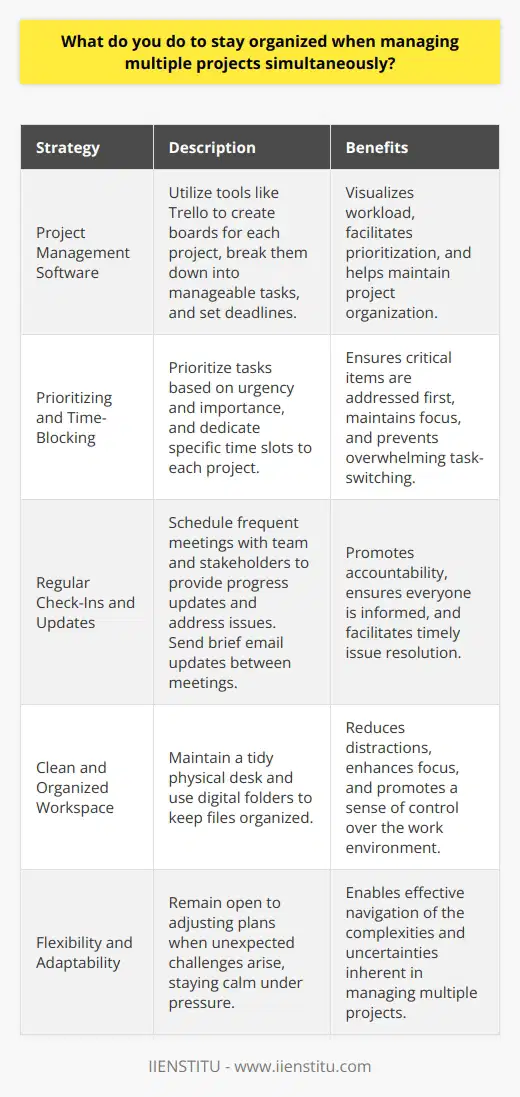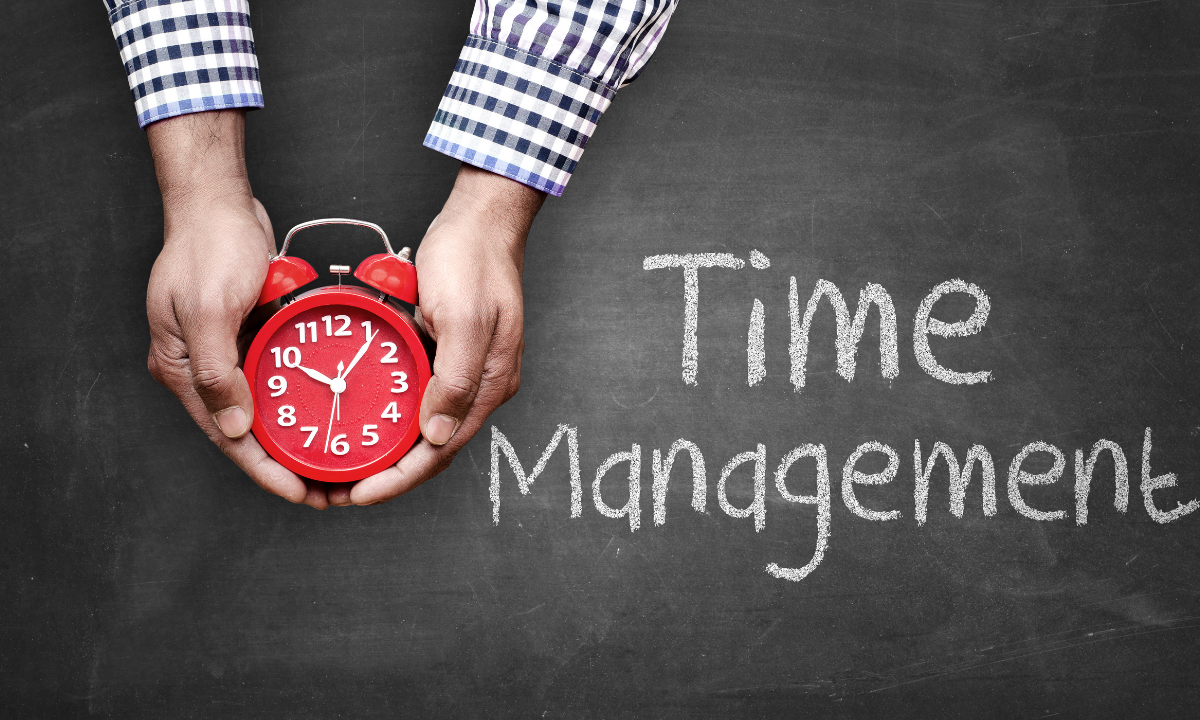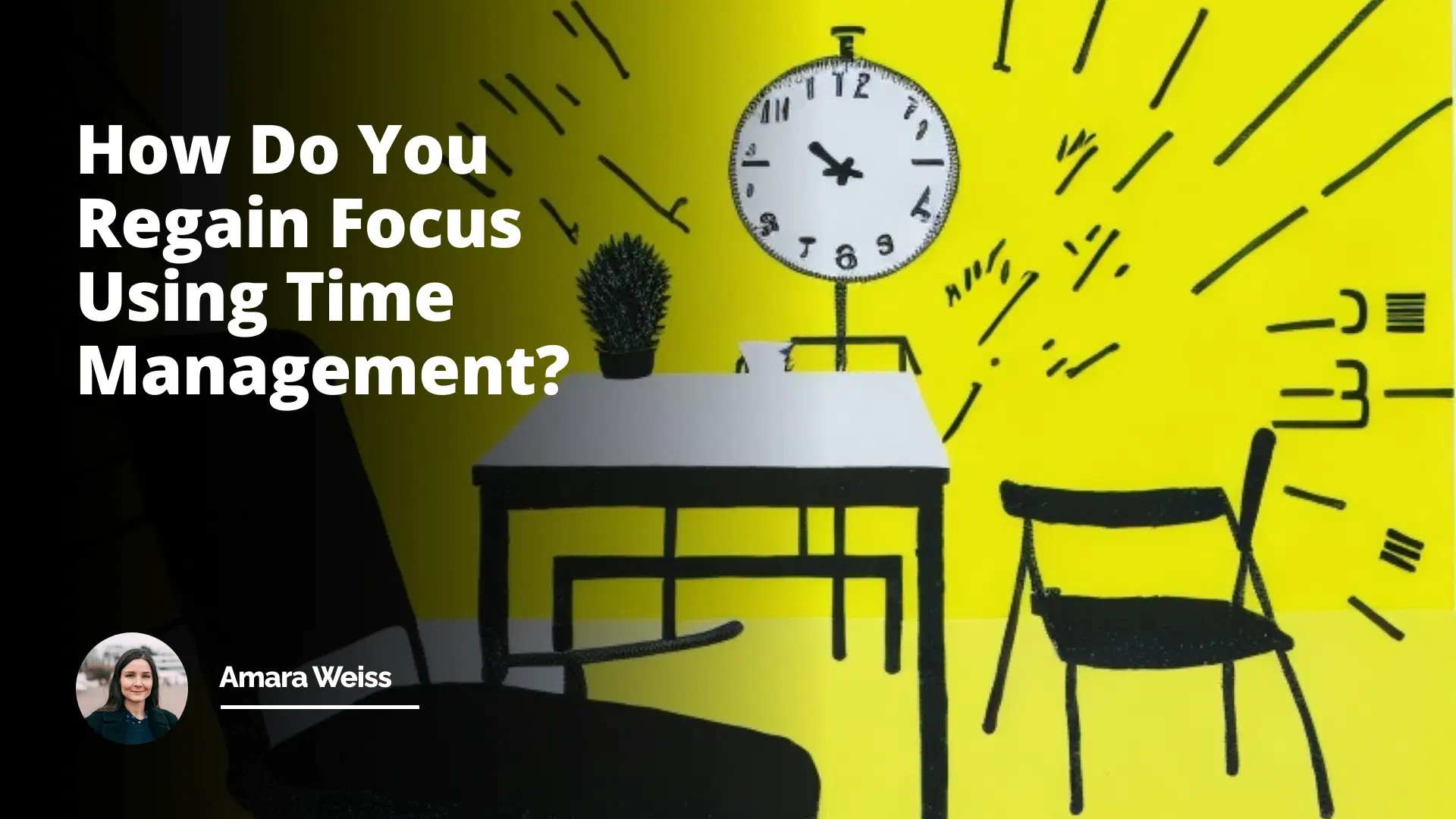
In an increasingly dynamic and fast-paced work environment, the ability to focus and manage time effectively is an indispensable asset. It's no surprise that human resources professionals are starting to ask, "How do you regain focus using time management?" during job interviews.
Related Course: Time Management Course
This question not only gauges the candidate's personal effectiveness but also their productivity, which ultimately impacts the organization's success.
The interviewer wants to understand your individual strategies for staying focused and how you utilize time management to accomplish tasks.
The purpose of the question: How do you regain focus using time management?
The crux of this question lies in its significance - it's not simply about regaining focus or managing time effectively; it's about the combination of the two.
In essence, the interviewer seeks to understand how you tackle distractions, how you prioritize tasks, and how you navigate through the challenging times of disarray.
They want an insight into your problem-solving process, your self-discipline, and your adaptability skills.
At what interview level is it asked?
Interview Question: How Did You Improve a Digital Marketing ROI?
Interview Question: What Personal Time Management Habit Changed Your Work Life?
Keeping pace with the need for efficiency and productivity, this question has found its place across varied levels of interviews.
Whether you're a fresher stepping into the professional world or an experienced professional aiming for the executive ladder, expect to hear it. After all, maintaining focus and managing time well are desirable skills, irrespective of your position or level within the company.
What kind of answer is expected from the candidate?
When asked, "How do you regain focus using time management?", the interviewer expects a structured, thoughtful answer. They look for practical examples demonstrating your ability to regain focus when distracted and how you use time management techniques to improve your productivity. Share instances from your past experiences where your focus was disrupted and how you managed to regain it. And remember, the more specific, the better.
Possible answers to consider
Before we dive in, remember that your answer must be personalized. What works for one may not work for the other. However, here are a few strategies that could be included:
Prioritize tasks: Explain how you rank your tasks based on importance and urgency, allowing you to focus on the tasks that deliver the most value.
Set SMART goals: Describe how setting Specific, Measurable, Achievable, Relevant, and Time-bound goals helps you to regain and maintain focus.
Breaks and relaxation: Elaborate on how taking regular, calculated breaks helps refresh the mind and renew your focus.
Calm the chaos: Explain your strategy of maintaining a tidy, well-organized workspace to minimize distractions and improve focus.
Use aids: Discuss your knack for using technology and productivity tools (such as Pomodoro timers, productivity apps, or white noise generators) for effective time management and maintaining focus.
Finally, conquering the art of regaining focus through effective time management takes practice and perseverance.
So, next time when faced with the question, "How do you regain focus using time management?", ensure that your response not only highlights your focus and time management strategies but also emphasizes your commitment to continuous learning and improvement.
In doing so, you'll demonstrate your resilience, professionalism, and commitment to productivity.
Time Management Techniques to Improve Focus
Task Prioritization Table
Tools and Apps for Enhancing Focus through Time Management
Similar interview questions:
What are some ways to regain focus through effective time management?
How can one improve their concentration by managing their time better?
Can you provide strategies for regaining focus by using time management skills?
How can time management techniques help in refocusing?
What time management practices can be implemented to regain focus?
How does good time management enable better focus?
Could you describe how time management aids in regaining focus?
Can practicing efficient time management help in refocusing the mind?
How does redefining time management habits lead to improved focus?
In what ways does effective time management enhance focus?

Frequently Asked Questions
How do you prioritize tasks when you have multiple deadlines?
When faced with multiple deadlines, I prioritize tasks based on their urgency and importance.
Assess Urgency and Importance
I first evaluate each task's due date and its significance to the company's goals. This helps me determine which tasks need immediate attention and which can wait.
I also consider the potential consequences of not completing a task on time. Will it impact other projects or cause issues for clients or colleagues?
Create a To-Do List
Once I've assessed the tasks, I make a to-do list, ranking items from most to least pressing. I find that writing things down helps me stay organized and focused.
Throughout the day, I refer back to my list and adjust priorities as needed. If something urgent comes up, I'll shift my focus to address it promptly.
Break Tasks into Manageable Steps
For larger projects, I break them down into smaller, more manageable steps. This makes the work feel less overwhelming and allows me to make steady progress, even when juggling multiple deadlines.
I set mini-deadlines for each step to ensure I'm staying on track and avoiding last-minute rushes.
Communicate and Collaborate
If I'm working on a team project, I maintain open communication with my colleagues. We discuss each person's responsibilities and deadlines to ensure everyone is aligned and working efficiently.
If I foresee any challenges or delays, I proactively communicate with my team or supervisor. Together, we can find solutions or adjust expectations as needed.
By staying organized, focused, and communicative, I'm able to effectively manage multiple deadlines and deliver high-quality work on time.
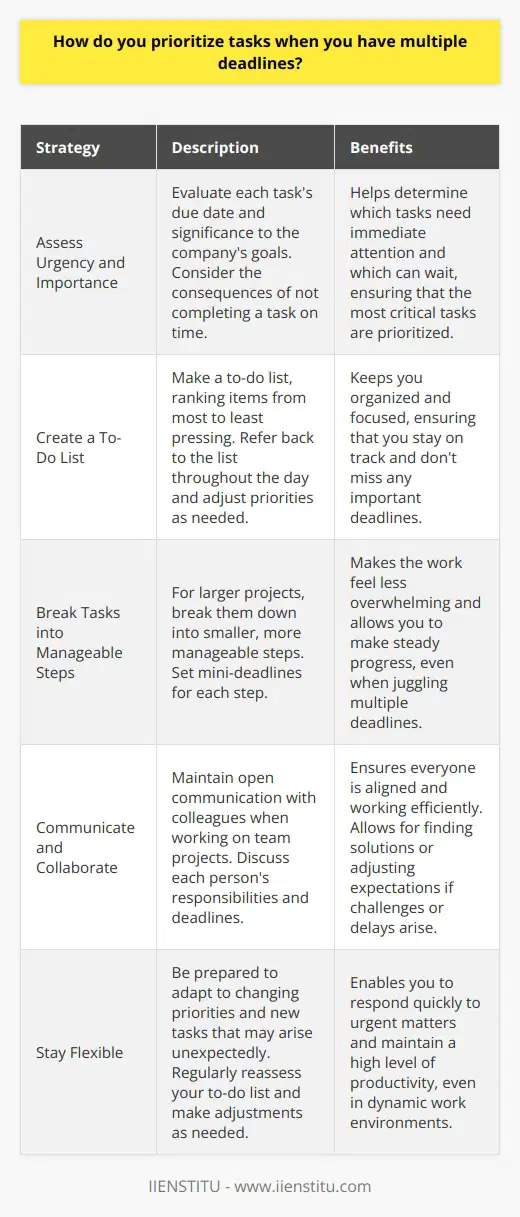
What strategies do you use to minimize distractions?
I have developed several effective strategies to minimize distractions and maintain focus throughout the workday. One key approach is to prioritize my tasks and create a daily schedule. By identifying the most critical responsibilities and allocating specific time blocks for each, I can ensure that I dedicate my full attention to the work at hand.
Eliminating Digital Distractions
I find it helpful to silence notifications on my phone and computer when working on important projects. This prevents the constant pings and pop-ups from disrupting my concentration. If necessary, I even put my phone in another room to avoid the temptation of checking it unnecessarily.
Creating a Focused Work Environment
Another strategy I employ is to create a clean, organized workspace that promotes focus. I keep my desk tidy and free from clutter, which helps me feel more in control and less overwhelmed. If I'm working on a particularly challenging task, I might even put on noise-canceling headphones to block out any background noise.
Taking Regular Breaks
Interestingly, I've found that taking short, periodic breaks actually enhances my productivity. Every hour or so, I step away from my desk for a few minutes to stretch, grab a glass of water, or do a quick meditation exercise. These brief moments of respite help me recharge and return to my work with renewed energy and clarity.
By implementing these strategies consistently, I've been able to significantly reduce distractions and maintain a high level of focus and productivity in my work.
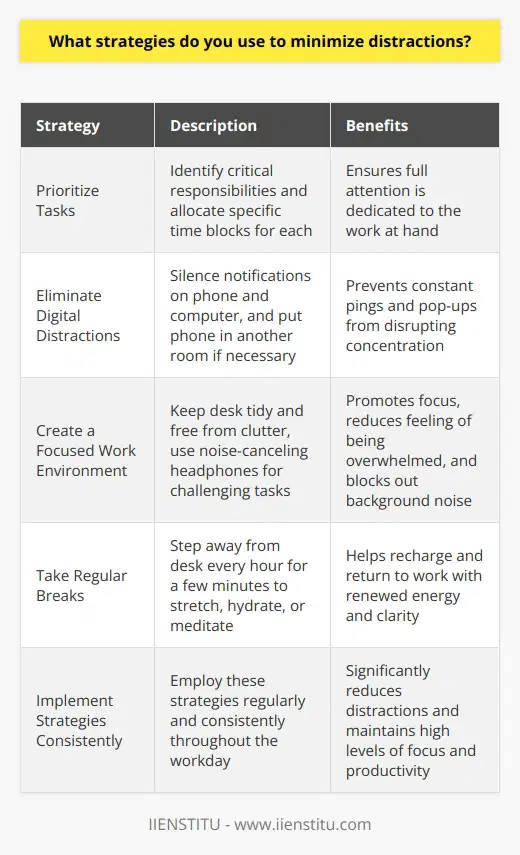
How do you handle interruptions while working on important projects?
When it comes to handling interruptions while working on important projects, I have developed several strategies over the years. One of the most effective approaches is to prioritize tasks based on their urgency and importance.
Prioritizing Tasks
I create a to-do list at the beginning of each day, ranking tasks from most to least critical. This helps me stay focused on the essential items, even when interruptions arise.
Communicating with Colleagues
Open communication is key to managing interruptions. I make sure my colleagues know when I'm working on high-priority projects and kindly ask them to limit non-urgent interruptions during those times.
Setting Boundaries
When necessary, I politely decline interruptions that can wait until later. I've learned that it's okay to say no sometimes in order to stay on track with important tasks.
Utilizing Time-Blocking
I often use the time-blocking method, dedicating specific chunks of time to different tasks or projects. This helps me stay organized and minimizes the impact of interruptions on my overall productivity.
Staying Flexible
Despite my best efforts, interruptions are sometimes unavoidable. When they do occur, I try to remain flexible and adjust my schedule accordingly, always keeping the big picture in mind.
At the end of the day, handling interruptions is about finding a balance between staying focused and being responsive to the needs of my team. With the right strategies in place, I'm able to navigate interruptions while still delivering high-quality work on important projects.
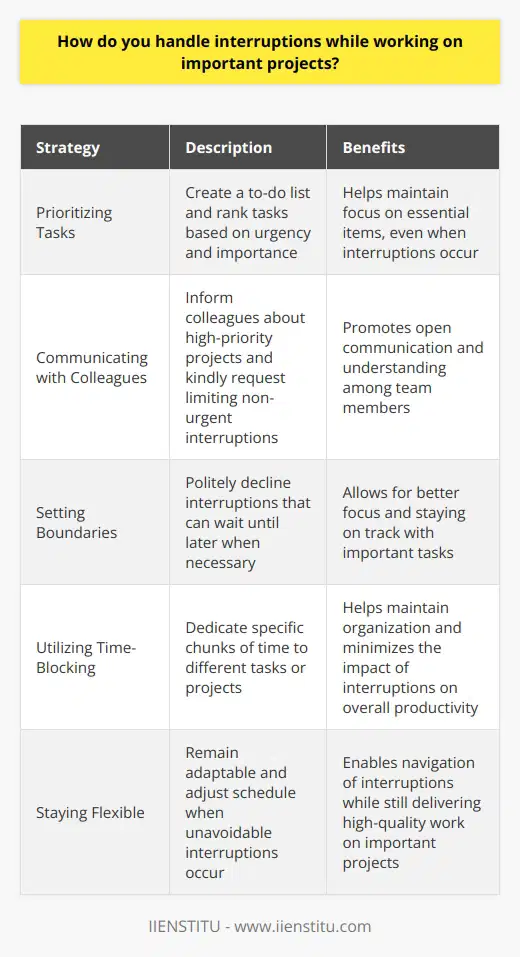
What techniques do you employ to stay organized and on track?
I employ several techniques to stay organized and on track, ensuring that I remain productive and efficient.
Prioritizing Tasks
I prioritize my tasks based on urgency and importance. This helps me focus on the most critical responsibilities first. By tackling high-priority items, I ensure that I make significant progress towards my goals each day.
Using a Planner
I rely on a physical planner to keep track of my appointments, deadlines, and to-do lists. Writing things down helps me remember them better and provides a visual overview of my schedule. I review my planner every morning to plan my day and stay on top of my commitments.
Breaking Down Projects
When faced with large projects, I break them down into smaller, manageable tasks. This approach makes the project less overwhelming and allows me to focus on one step at a time. I set milestones and deadlines for each task to ensure steady progress.
Minimizing Distractions
I minimize distractions by creating a dedicated workspace and setting boundaries. I silence notifications on my phone and computer when working on important tasks. This helps me maintain focus and avoid interruptions that can derail my productivity.
Regular Check-Ins
I schedule regular check-ins with myself to assess my progress and make adjustments as needed. These check-ins allow me to reflect on my accomplishments, identify areas for improvement, and ensure that I'm staying on track with my goals.
By employing these techniques, I maintain a high level of organization and productivity in my work.

How do you break down large tasks into manageable steps?
When faced with a large task, I always start by clearly defining the end goal. This helps me understand what needs to be accomplished and keeps me focused on the desired outcome.
Next, I break the task down into smaller, more manageable steps. I identify the key milestones and deliverables that will lead me to the final goal. By creating a roadmap of smaller tasks, the overall project feels less overwhelming and more achievable.
Prioritize and Sequence
After breaking the task into smaller steps, I prioritize them based on importance and dependencies. I determine which steps are critical and must be completed first, and which ones can be tackled later. This helps me create a logical sequence of actions.
Set Realistic Deadlines
I assign realistic deadlines to each step, taking into account the time and resources required. Having clear timelines keeps me accountable and ensures that I make steady progress towards the end goal.
Regular Review and Adjustments
Throughout the process, I regularly review my progress and make adjustments as needed. If I encounter obstacles or delays, I reassess my plan and make necessary changes to stay on track.
By breaking large tasks into smaller, manageable steps, I can tackle complex projects with confidence and efficiency. This approach helps me maintain focus, avoid overwhelm, and ultimately achieve successful outcomes.
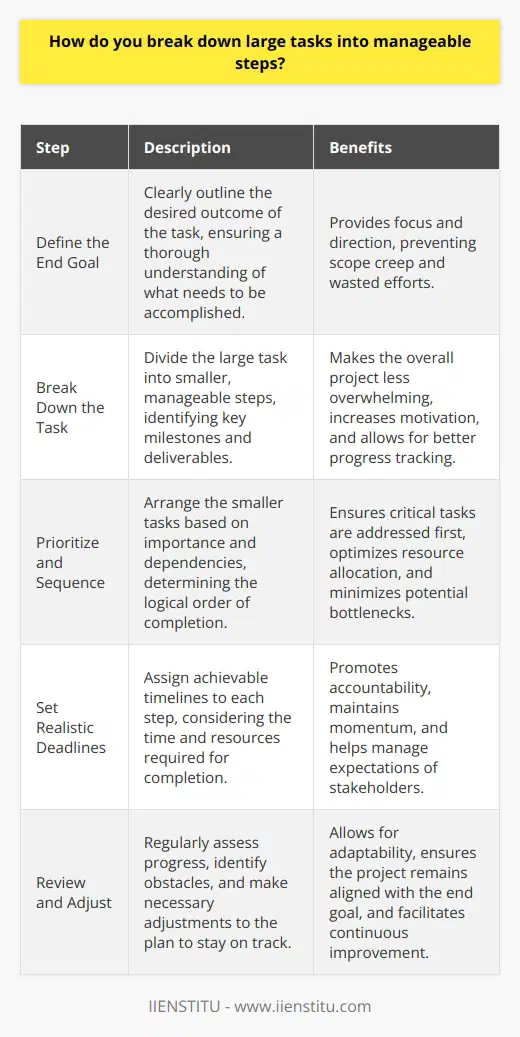
What methods do you use to estimate the time required for each task?
When estimating the time required for each task, I use a combination of methods to ensure accuracy. First, I break down the task into smaller, manageable subtasks. This allows me to analyze each component individually.
Leveraging Past Experience
I draw upon my past experiences with similar tasks to gauge the time needed. For example, when I was working on a website redesign project last year, I realized that the initial wireframing phase typically takes me around 3 days. This helps me set realistic expectations for current projects.
Conducting Research
If I'm faced with a new or unfamiliar task, I conduct thorough research. I consult with colleagues, read industry blogs, and explore online forums to gather insights from professionals who have tackled similar challenges. This helps me develop a well-informed time estimate.
Adding Buffer Time
I always add a reasonable buffer time to my estimates to account for unexpected obstacles or delays. I've learned that it's better to overestimate slightly than to underestimate and face the stress of tight deadlines.
Continuous Refinement
Throughout the project, I continuously refine my time estimates based on the progress made and any new information gathered. I believe in being adaptable and adjusting my approach when necessary to ensure the most accurate estimates possible.
By combining these methods, I strive to provide reliable time estimates that enable effective project planning and management. It's an ongoing learning process, and I'm committed to refining my estimation skills with each new challenge I face.
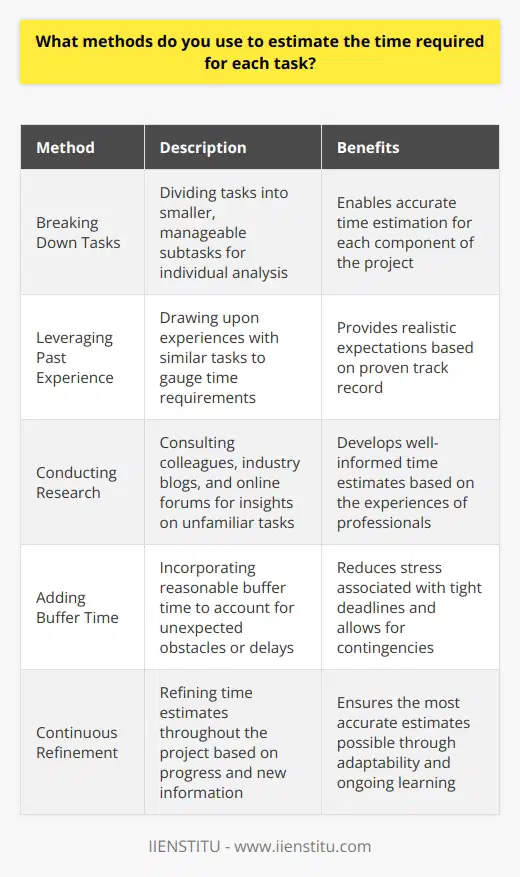
How do you ensure that you allocate sufficient time for high-priority tasks?
When it comes to ensuring that I allocate sufficient time for high-priority tasks, I have a few strategies that have worked well for me throughout my career.
Prioritize ruthlessly
First and foremost, I prioritize ruthlessly. I take a hard look at my to-do list and identify the tasks that will have the biggest impact on my goals and the company's objectives. These are the tasks that get my attention first.
Break down big tasks
For larger, high-priority projects, I break them down into smaller, manageable chunks. This makes them less daunting and allows me to make steady progress, even when my schedule is packed.
Block out focused time
I also block out dedicated time on my calendar for deep, focused work on these important tasks. I treat these blocks as sacred and do my best to minimize distractions during these periods.
Communicate with my team
Communication is key. I keep my team and stakeholders informed about my priorities and progress. This helps manage expectations and ensures everyone is aligned.
Stay flexible
That said, I also stay flexible. Priorities can shift quickly in a fast-paced work environment. I regularly reassess my task list and adjust as needed to ensure I'm always focusing on the most critical items.
By using these strategies consistently, I've been able to consistently deliver on my most important responsibilities, even during the busiest times. It's an approach that has served me well and one I plan to continue refining as I grow in my career.

What tools or technologies do you utilize to manage your time effectively?
I utilize a combination of digital tools and traditional methods to effectively manage my time. My go-to app is Todoist, which allows me to create tasks, set deadlines, and organize projects. I love how it syncs seamlessly across all my devices, ensuring I always have access to my to-do list.
Prioritizing Tasks
In addition to digital tools, I rely on the tried-and-true method of prioritizing tasks using the Eisenhower Matrix. This approach helps me distinguish between urgent and important tasks, enabling me to focus on what truly matters. I dedicate my mornings to tackling the most critical and challenging tasks when my energy levels are at their peak.
Time Blocking
Another strategy I employ is time blocking. I allocate specific time slots for different activities, such as deep work, meetings, and email management. This technique helps me maintain focus and avoid getting sidetracked by less important tasks. I've found that using a physical planner alongside my digital calendar enhances my productivity and keeps me accountable.
Regular Reviews
To stay on top of my commitments, I conduct regular reviews of my tasks and goals. Every Friday afternoon, I take a step back and assess my progress, making adjustments as needed. This habit allows me to enter the weekend with a clear mind and a sense of accomplishment.
Continuous Improvement
I'm always eager to learn and improve my time management skills. I actively seek out productivity blogs, podcasts, and books to discover new techniques and best practices. Implementing these insights has helped me streamline my workflows and boost my efficiency over time.
By leveraging a mix of digital tools, proven strategies, and a commitment to continuous improvement, I've developed a robust system for managing my time effectively. This approach enables me to stay organized, prioritize what matters, and consistently deliver high-quality work.
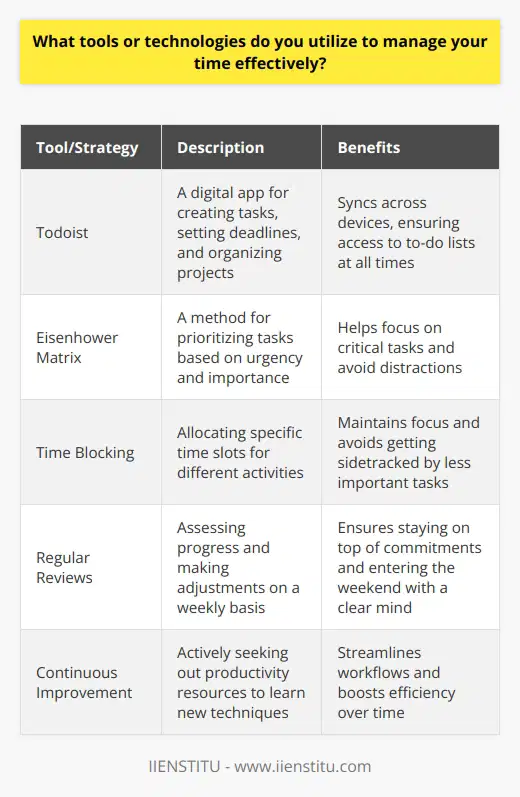
How do you handle situations when you feel overwhelmed by your workload?
When I feel overwhelmed by my workload, I take a step back and prioritize my tasks. I assess which tasks are most critical and tackle those first.
Communication is Key
If the workload becomes unmanageable, I communicate with my supervisor or team members. Together, we can redistribute tasks or adjust deadlines to ensure everything gets done without sacrificing quality.
Staying Organized
I find that staying organized helps me manage stress during busy periods. I use tools like calendars, to-do lists, and project management software to keep track of my responsibilities and deadlines.
Self-Care Matters
When I'm feeling particularly stressed, I make sure to take short breaks throughout the day. Even just a few minutes of deep breathing or stretching can help me refocus and recharge.
At the end of the day, I try to leave work at work. Disconnecting from job-related stress during my off-hours allows me to return to the office refreshed and ready to tackle new challenges.
Learning from Experience
Over time, I've learned to recognize the signs of burnout and take proactive steps to prevent it. By staying organized, communicating effectively, and prioritizing self-care, I'm able to handle even the busiest workloads without feeling overwhelmed.
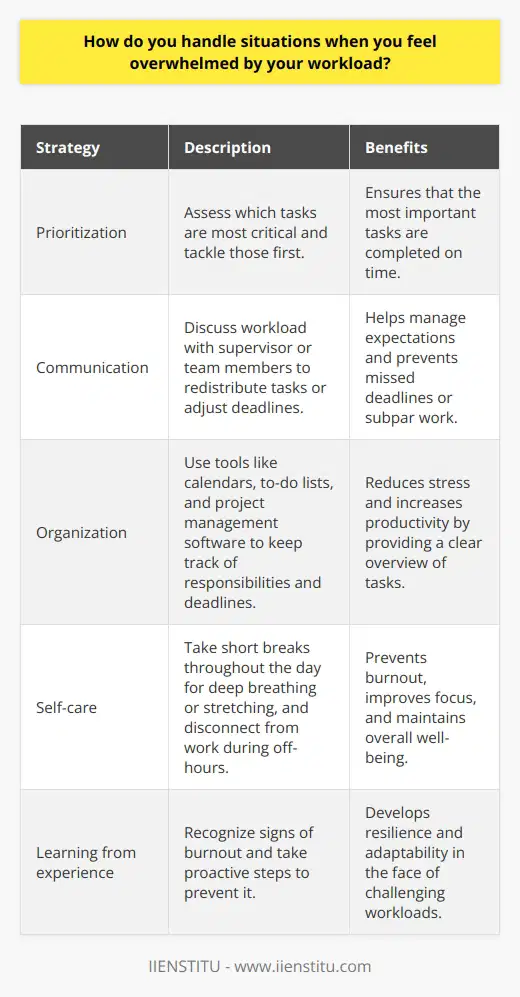
What do you do when you find yourself procrastinating?
When I find myself procrastinating, I take a step back and try to understand the root cause. Often, it's because I'm feeling overwhelmed or uncertain about how to proceed with a task. To overcome this, I break the task down into smaller, more manageable steps.
Set Clear Goals and Deadlines
I set clear goals for each step and give myself realistic deadlines. This helps me stay focused and motivated. I also prioritize my tasks based on their importance and urgency, tackling the most critical ones first.
Eliminate Distractions
I find that eliminating distractions is key to overcoming procrastination. I turn off notifications on my phone and close unnecessary tabs on my computer. If I'm working from home, I create a dedicated workspace that's free from clutter and other potential distractions.
Take Breaks and Reward Yourself
I also make sure to take regular breaks to avoid burnout and maintain my productivity. During these breaks, I engage in activities that I enjoy, such as going for a quick walk or listening to music. I also reward myself for completing tasks, which helps me stay motivated and focused.
Overall, overcoming procrastination is about understanding why you're putting things off and developing strategies to stay on track. By setting clear goals, eliminating distractions, and taking breaks, I'm able to stay productive and achieve my objectives.
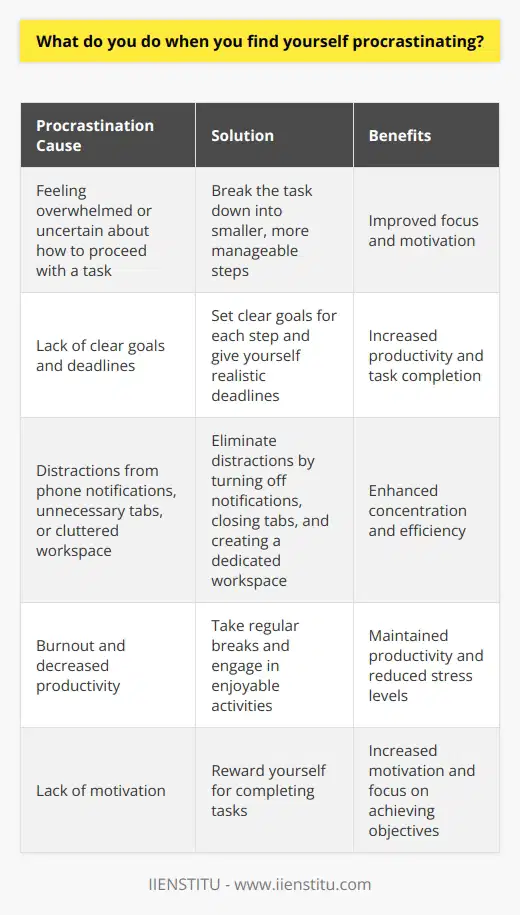
How do you maintain a healthy work-life balance while meeting deadlines?
Maintaining a healthy work-life balance while meeting deadlines is all about time management and setting boundaries. I prioritize my tasks based on urgency and importance, and I break down larger projects into smaller, manageable steps. This helps me stay focused and avoid feeling overwhelmed.
Communicate with Your Team
I make sure to communicate regularly with my team and my manager about my workload and any potential challenges. If I feel like I'm taking on too much, I'm not afraid to speak up and ask for help or delegate tasks when necessary. It's important to be honest about your capacity and limitations.
Set Realistic Expectations
When taking on new projects or deadlines, I always make sure to set realistic expectations upfront. I consider my existing workload and other commitments before agreeing to anything new. It's better to underpromise and overdeliver than the other way around.
Take Breaks and Disconnect
To avoid burnout, I make sure to take regular breaks throughout the day, even if it's just a few minutes to stretch or grab a snack. When I'm not at work, I try to disconnect completely and focus on my personal life and hobbies. This helps me recharge and come back to work feeling refreshed and energized.
Learn to Say No
Finally, I've learned that it's okay to say no sometimes. If I'm already stretched thin and taking on more work would compromise my work-life balance or the quality of my output, I politely decline or suggest an alternative solution. Setting boundaries is key to maintaining a healthy balance between work and personal life.
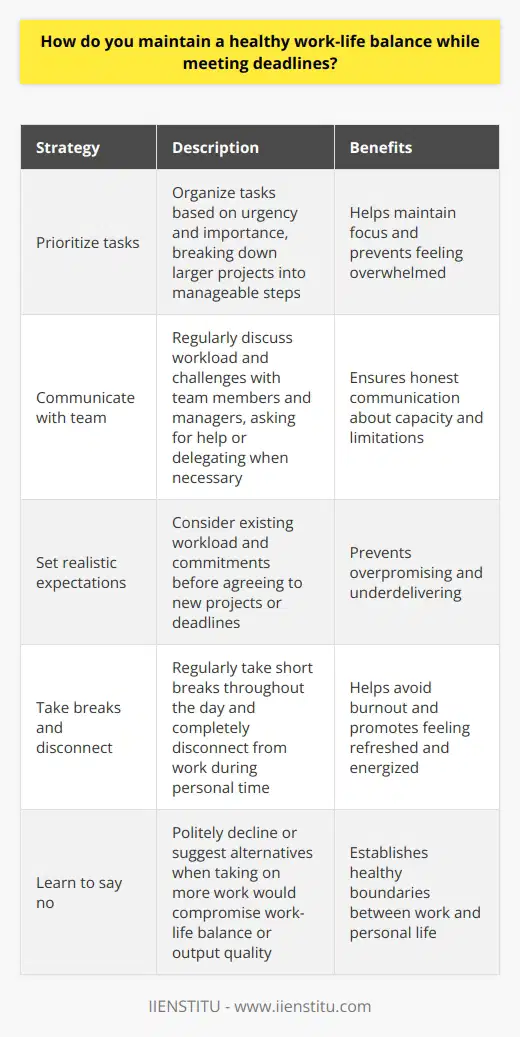
What techniques do you use to avoid multitasking and stay focused on one task at a time?
When it comes to staying focused on one task at a time, I have a few go-to techniques that help me avoid the temptation of multitasking. It's not always easy, but with practice and dedication, I've found that these methods work well for me.
Prioritize and Plan
I start each day by prioritizing my tasks and creating a plan of action. I break down larger projects into smaller, manageable steps and focus on completing one step at a time. This helps me stay organized and reduces the urge to jump between tasks.
Eliminate Distractions
I find that eliminating distractions is key to maintaining focus. I turn off notifications on my phone and computer, close unnecessary tabs, and let my colleagues know when I need uninterrupted time to work. Creating a quiet, clutter-free workspace also helps me stay on track.
Take Breaks
Taking regular breaks might seem counterintuitive, but it's actually essential for maintaining focus. I step away from my desk every hour or so to stretch, grab a snack, or take a quick walk. These short breaks help me recharge and return to my work with renewed energy and concentration.
Use Time-Blocking
Time-blocking is a technique I've found particularly useful. I dedicate specific blocks of time to each task and work on it exclusively during that period. This helps me stay accountable and ensures that I make progress on all of my priorities.
Practice Mindfulness
Finally, I try to practice mindfulness throughout the day. When I feel my mind starting to wander, I take a few deep breaths and refocus my attention on the present moment. This helps me stay grounded and avoid getting caught up in the cycle of multitasking.
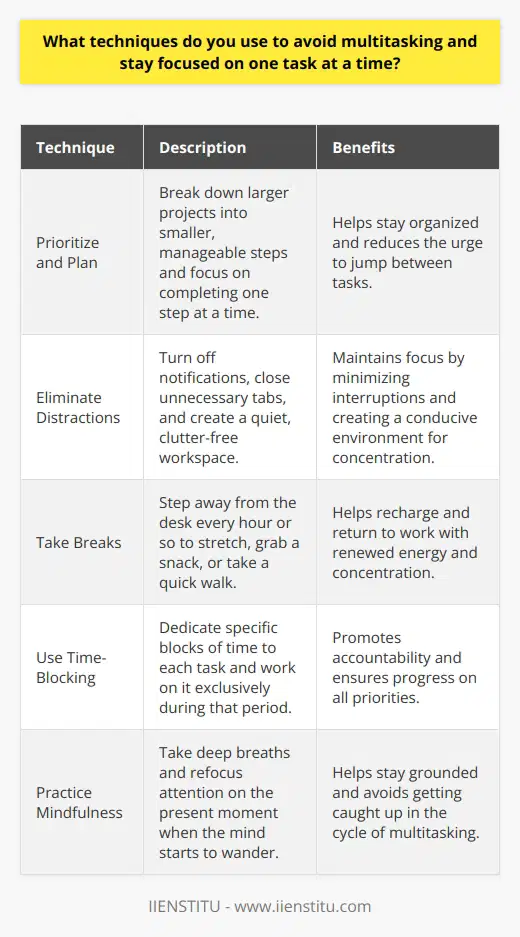
How do you adapt your time management strategies to different types of projects?
When it comes to adapting my time management strategies for different projects, I focus on three key areas:
Prioritizing Tasks
I start by identifying the most critical tasks for each project and tackle those first. This helps me make steady progress and ensures I'm always working on the most important items.
For example, when I was working on a complex software development project last year, I made sure to prioritize the core functionality before moving on to the nice-to-have features. This kept the project on track and allowed us to deliver a solid product on time.
Adjusting My Schedule
Depending on the project's needs, I may need to adjust my daily or weekly schedule. If a project requires more collaboration, I'll block off more time for meetings and team check-ins.
I remember a marketing campaign I worked on that required a lot of coordination between different departments. I adapted my schedule to include more cross-functional meetings, which helped keep everyone aligned and moving forward.
Staying Flexible
No matter how well I plan, unexpected challenges can always arise. That's why I stay flexible and ready to adjust my approach as needed.
A few months ago, I was leading a project when we encountered a major roadblock. Instead of sticking rigidly to the original plan, I quickly reassessed the situation and worked with my team to find a creative solution. By staying adaptable, we were able to overcome the obstacle and still hit our deadline.
At the end of the day, effective time management is about understanding the unique needs of each project and being willing to adjust your strategies accordingly. It's a skill I've honed over time, and one that I believe has been key to my success in managing a wide variety of projects.
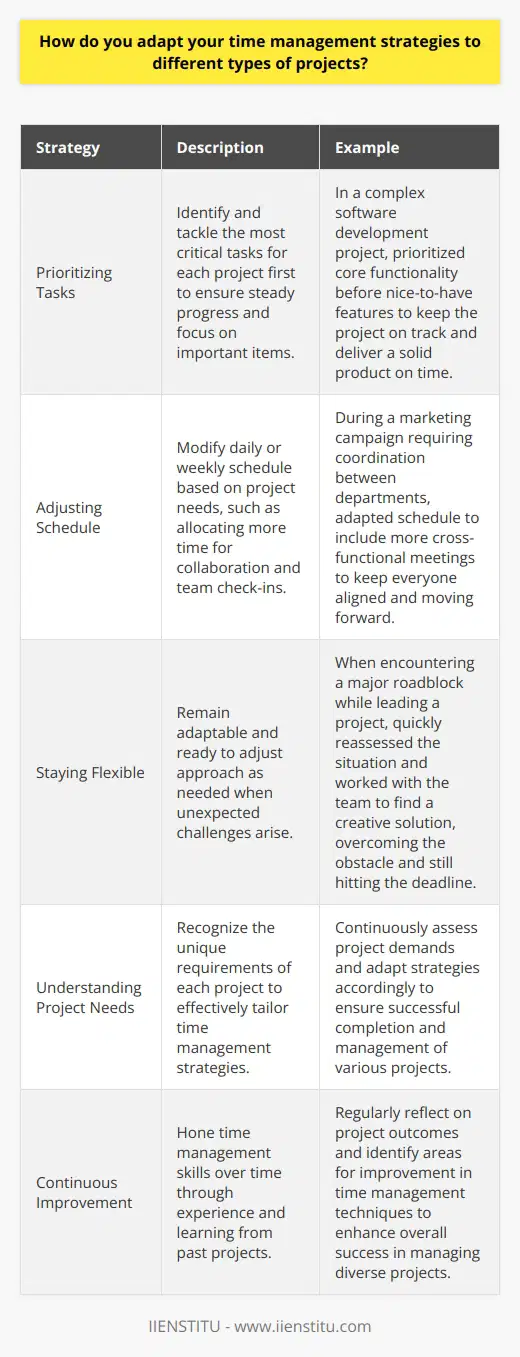
What do you do when you realize you're behind schedule on a project?
When I realize I'm behind schedule on a project, the first thing I do is take a deep breath and assess the situation. It's important not to panic, but rather to calmly evaluate what needs to be done to get back on track.
Communicate with the Team
I immediately communicate with my team and stakeholders about the delay. Transparency is key in these situations. I explain the reasons behind the setback and propose a plan of action to mitigate the issue.
Prioritize Tasks
Next, I prioritize the remaining tasks based on their importance and urgency. I focus on the critical path items that have the most significant impact on the project's success. This helps me allocate resources effectively and ensure that the most crucial aspects of the project are addressed first.
Collaborate and Delegate
I collaborate with my team members to see if we can divide and conquer. By delegating tasks and leveraging the strengths of each individual, we can work more efficiently and make up for lost time. I also reach out to colleagues from other departments if additional support is needed.
Adjust the Timeline
If necessary, I propose adjustments to the project timeline. I work with stakeholders to identify areas where we can compress the schedule without compromising quality. This may involve reducing the scope of certain deliverables or finding innovative ways to streamline processes.
Throughout the process, I maintain open lines of communication, provide regular progress updates, and remain flexible. By being proactive, collaborative, and solution-oriented, I strive to get the project back on track and deliver the best possible outcome, even in the face of challenges.
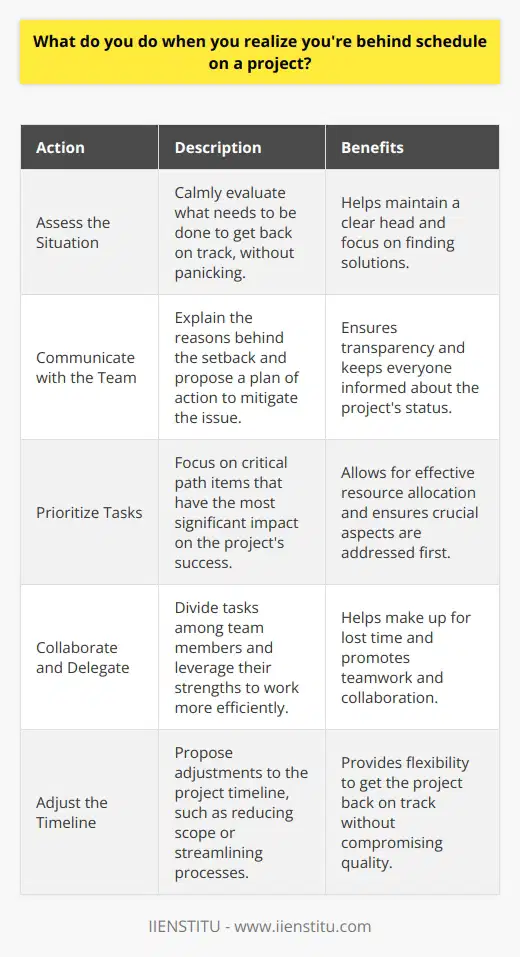
How do you communicate with your team or manager when you need to adjust your priorities?
When I need to adjust my priorities, I believe in open and honest communication with my team and manager. I start by clearly explaining the situation and the reasons behind the necessary changes. This helps everyone understand the context and the importance of the adjustments.
Proactive Approach
I take a proactive approach by suggesting potential solutions and alternative plans. By coming prepared with ideas, I demonstrate my problem-solving skills and commitment to finding the best way forward. I also make sure to listen actively to any feedback or concerns from my colleagues and manager.
Collaboration and Transparency
Collaboration is key in these situations. I work closely with my team to redistribute tasks and ensure a smooth transition. Transparency is equally important. I keep everyone informed about the progress and any challenges that arise along the way.
Adaptability and Flexibility
Adaptability and flexibility are essential qualities I bring to the table. I'm always ready to pivot when necessary and embrace new strategies to achieve our goals. I believe that being open to change and willing to adjust course is crucial for success in any role.
Continuous Learning
Throughout the process, I see every challenge as an opportunity for growth and learning. I reflect on what I could have done differently and use those insights to improve my approach in the future. By continuously learning and adapting, I strive to become a better communicator and team player.
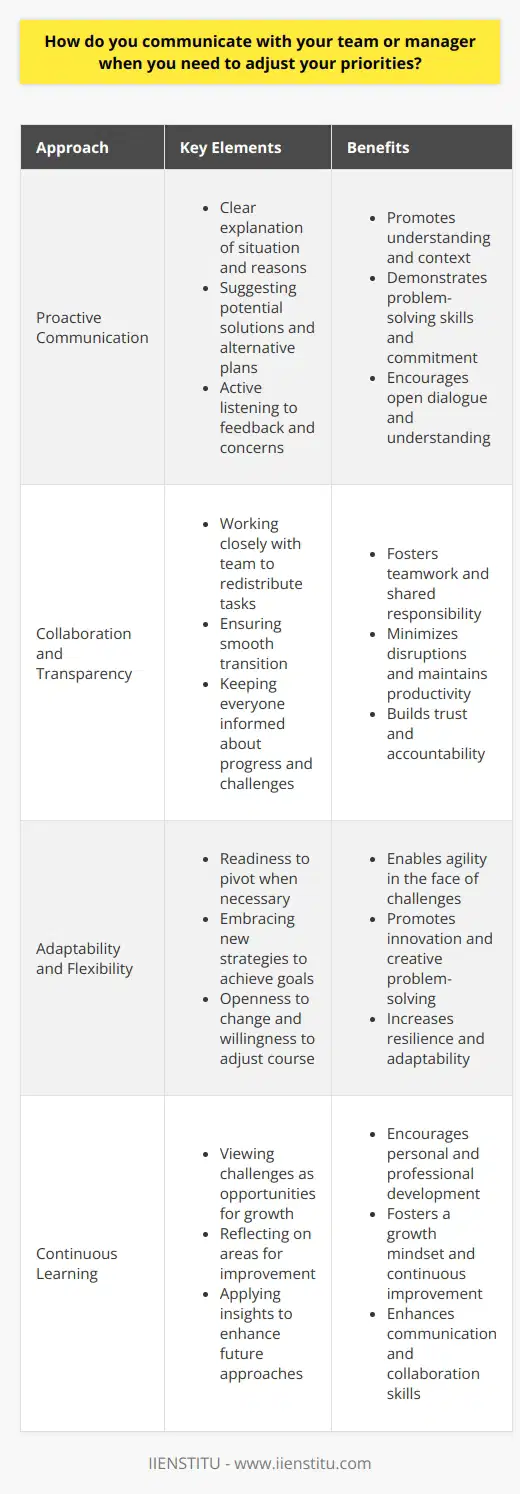
What strategies do you use to stay motivated and avoid burnout?
When it comes to staying motivated and avoiding burnout, I've found that setting clear goals is crucial. I break down larger objectives into smaller, manageable tasks and celebrate each milestone along the way. This helps me maintain a sense of progress and keeps me energized.
Prioritizing Self-Care
I also prioritize self-care to prevent burnout. I make sure to take regular breaks throughout the day, even if it's just a few minutes to stretch or grab a healthy snack. Exercise is another important part of my routine - I find that a quick jog or yoga session can do wonders for my mental clarity and overall wellbeing.
Surrounding Myself with Positivity
Another strategy I use is surrounding myself with positive influences. I seek out mentors and colleagues who inspire me and offer constructive feedback. When I'm feeling stressed or overwhelmed, talking through challenges with someone I trust can provide a fresh perspective and renewed motivation.
Embracing a Growth Mindset
Finally, I try to embrace a growth mindset. Instead of getting discouraged by setbacks, I view them as opportunities to learn and improve. Remembering my past successes and the obstacles I've overcome helps me stay resilient in the face of new challenges.
By setting achievable goals, prioritizing self-care, seeking out positive influences, and maintaining a growth mindset, I'm able to stay motivated and engaged in my work while avoiding burnout. It's an ongoing process, but one that I'm committed to for the sake of my personal and professional wellbeing.
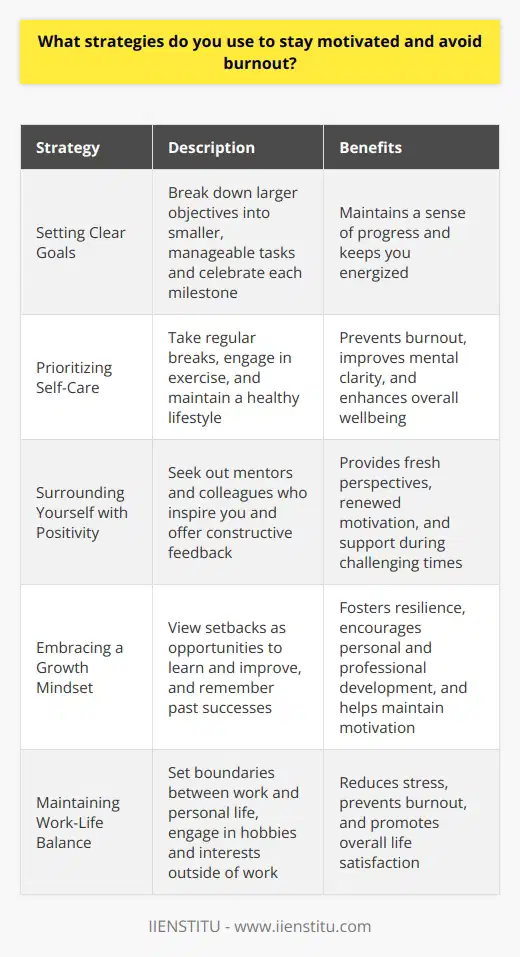
How do you handle unexpected tasks or changes in priorities?
When faced with unexpected tasks or changes in priorities, I approach the situation with a positive and adaptable mindset. I understand that in any professional setting, the ability to be flexible is crucial for success.
Assess the Situation
First, I take a moment to assess the new task or change in priority. I gather all the necessary information and clarify any uncertainties with my supervisor or colleagues. This helps me understand the scope and urgency of the situation.
Prioritize and Plan
Next, I prioritize my tasks based on their importance and deadline. I create a plan of action, breaking down the unexpected task into smaller, manageable steps. This allows me to tackle the challenge in an organized and efficient manner.
Communicate and Collaborate
I believe in the power of communication and collaboration. I keep my team informed about the changes in my priorities and seek their input and support when needed. By working together, we can often find creative solutions and adapt to unexpected situations more effectively.
Stay Calm and Focused
Throughout the process, I remain calm and focused. I understand that getting stressed or overwhelmed will only hinder my productivity. Instead, I maintain a positive attitude and concentrate on the task at hand, knowing that I have the skills and resilience to overcome any challenges that come my way.
In my previous role, I once had to handle an unexpected client request with a tight deadline. By following these steps and collaborating with my team, we were able to deliver exceptional results and exceed the client's expectations. This experience taught me the importance of adaptability and teamwork in the face of unexpected challenges.
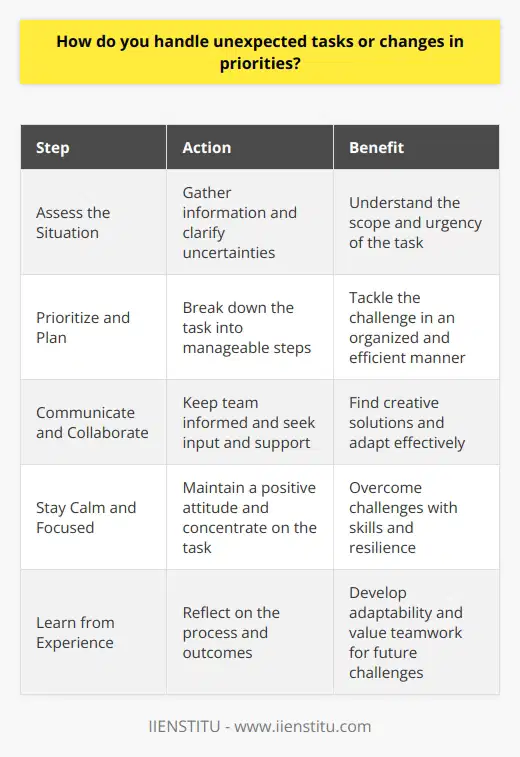
What do you do to recharge and maintain your productivity throughout the day?
To recharge and maintain my productivity throughout the day, I focus on three key areas: mindset, movement, and breaks.
Positive Mindset
I start each day by setting a positive intention and practicing gratitude. This helps me approach tasks with enthusiasm and resilience. When faced with challenges, I reframe them as opportunities for growth and learning.
Regular Movement
I prioritize physical activity to boost my energy and mental clarity. I take short walks during my lunch break and stretch at my desk every hour. This keeps my body and mind alert and focused.
Mindful Breaks
Throughout the day, I schedule brief breaks to disconnect and recharge. I might do a quick meditation, read a few pages of an inspiring book, or chat with a colleague. These moments of respite prevent burnout and help me return to work with fresh eyes.
Personalized Strategies
I've learned that everyone has different needs when it comes to maintaining productivity. Through trial and error, I've discovered the specific strategies that work best for me. For example, I find that listening to instrumental music helps me concentrate, while others might prefer complete silence.
By prioritizing self-care and listening to my own needs, I'm able to sustain my energy and focus throughout the day. This allows me to bring my best self to my work and contribute meaningfully to my team's success.

How do you prioritize tasks when everything seems equally important?
When faced with multiple tasks that seem equally important, I first take a step back and assess the situation. I consider the deadlines, the impact on the company's goals, and the consequences of not completing each task. This helps me gain clarity on which tasks are truly the most critical.
Prioritizing Based on Urgency and Importance
I use the Eisenhower Matrix to categorize tasks into four quadrants: urgent and important, important but not urgent, urgent but not important, and neither urgent nor important. I focus on the urgent and important tasks first, as they have the most significant impact and the tightest deadlines.
Breaking Down Large Projects
For large projects, I break them down into smaller, manageable tasks. This allows me to prioritize the most critical components and ensures that I make steady progress towards completing the overall project.
Communicating with Stakeholders
I also communicate with my team and stakeholders to understand their priorities and expectations. Their input helps me align my priorities with the company's goals and ensures that I'm focusing on the most important tasks from their perspective.
Staying Flexible and Adaptable
I remain flexible and adaptable, as priorities can change unexpectedly. I regularly reassess my priorities and adjust my focus as needed to ensure that I'm always working on the most important tasks.
Continuously Improving Time Management Skills
Ultimately, prioritizing tasks effectively is a skill that I continuously work on improving. I learn from my experiences, seek feedback from others, and implement new strategies to help me manage my time and priorities more efficiently.
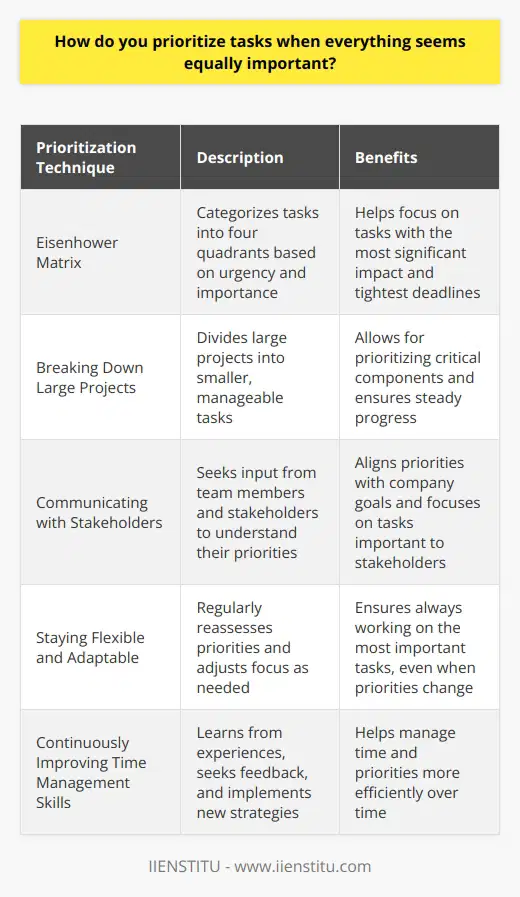
What techniques do you use to avoid getting bogged down in minor details?
I use several techniques to avoid getting bogged down in minor details. First, I prioritize tasks based on importance and urgency. This helps me focus on the big picture and not get sidetracked by trivial matters.
Delegation is key
Another strategy I employ is delegation. When possible, I assign minor details to team members who are better suited to handle them. This allows me to concentrate on high-level responsibilities that require my attention.
Setting realistic deadlines
I also set realistic deadlines for myself and my team. By allotting sufficient time for each task, I avoid rushing and making mistakes that could lead to getting bogged down in minor details.
Regular check-ins
Moreover, I schedule regular check-ins with my team to ensure everyone is on track and identify potential roadblocks early on. This proactive approach prevents minor issues from escalating into major problems.
Embracing flexibility
Finally, I embrace flexibility and adapt my approach as needed. If I find myself getting too caught up in details, I take a step back, reevaluate my priorities, and adjust my focus accordingly.
By using these techniques consistently, I maintain a high-level perspective and avoid letting minor details hinder my productivity and success.
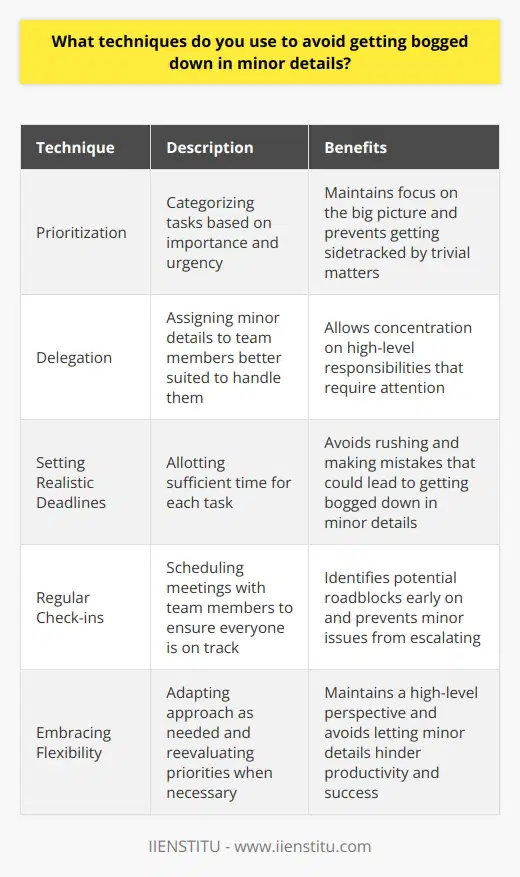
How do you ensure that you meet deadlines without compromising the quality of your work?
As a professional, I understand the importance of meeting deadlines without compromising the quality of my work. Over the years, I've developed a few strategies that help me consistently deliver excellent results on time.
Prioritize and Plan
When I receive a new project, I immediately assess its importance and deadline. I then break it down into smaller, manageable tasks and create a detailed plan with specific milestones. This helps me stay organized and focused throughout the process.
Communicate Effectively
I believe in open and honest communication with my team and clients. If I foresee any potential delays or challenges, I promptly inform the relevant parties and work with them to find a solution. Clear communication ensures everyone is on the same page and prevents last-minute surprises.
Manage Time Wisely
I'm a stickler for effective time management. I allocate specific time slots for each task and minimize distractions during those periods. When I feel overwhelmed, I take short breaks to recharge and return with renewed focus. This approach allows me to maintain a high level of productivity without burning out.
Leverage Resources
I'm not afraid to ask for help when needed. If I'm facing a particularly challenging task or tight deadline, I reach out to my colleagues or supervisors for guidance and support. Collaborating with others not only lightens my workload but also brings fresh perspectives and ideas to the table.
Continuously Improve
I believe in learning from every project, whether it's a success or a challenge. I take the time to reflect on my performance, identify areas for improvement, and implement those lessons in future endeavors. By continuously refining my skills and processes, I can deliver high-quality work more efficiently.
In summary, meeting deadlines without compromising quality is a skill I've honed over time. It requires a combination of planning, communication, time management, collaboration, and continuous improvement. I'm confident that my approach will enable me to excel in this role and contribute to the company's success.
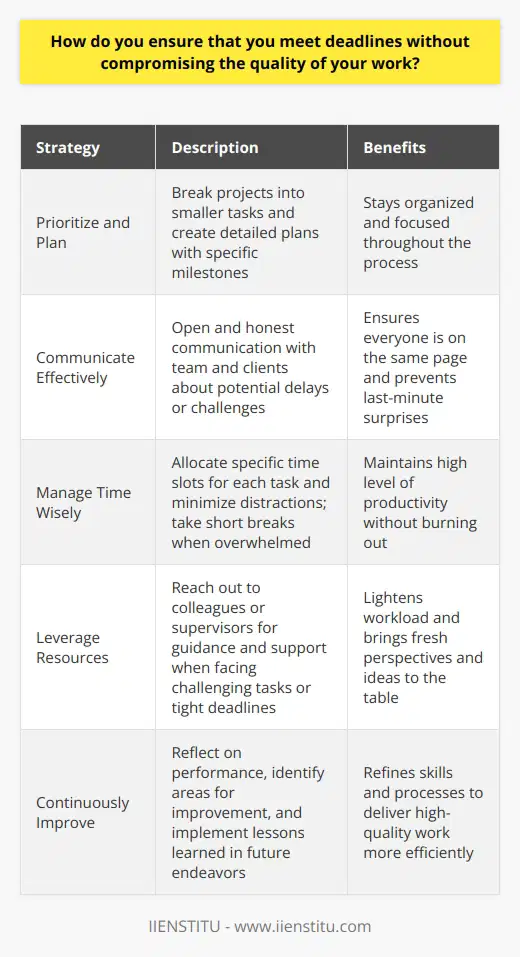
What do you do when you're stuck on a particular task and need to regain focus?
When I encounter a challenging task that requires me to regain focus, I take a strategic approach. First, I step back and analyze the problem from a fresh perspective. This often involves breaking it down into smaller, manageable components.
Seeking Inspiration
Next, I seek inspiration from various sources. I might consult with colleagues, read relevant articles, or watch informative videos. Exposure to new ideas can spark creative solutions and reignite my motivation.
Taking Breaks
If I'm truly stuck, I've learned that taking short breaks can work wonders. I'll step away from my desk, grab a cup of coffee, or take a quick walk outside. These moments of respite allow my mind to recharge and approach the problem with renewed energy.
Prioritizing and Planning
Once I've gained clarity, I prioritize the tasks at hand and create a detailed plan of action. I set realistic goals, allocate my time wisely, and tackle the most critical aspects first. Having a structured roadmap keeps me focused and accountable.
Staying Positive
Throughout the process, I maintain a positive attitude. I remind myself of past successes and the growth opportunities that challenges present. By embracing a growth mindset, I stay resilient and motivated, even when faced with obstacles.
In the end, regaining focus is about adapting, learning, and persevering. By employing these strategies, I've consistently overcome roadblocks and delivered high-quality work.

How do you manage your time when working on collaborative projects with others?
When working on collaborative projects, I prioritize effective communication and organization to manage my time efficiently. I believe in setting clear goals and expectations with my team from the outset. This helps us stay focused and aligned throughout the project.
Breaking Down Tasks
I find it helpful to break larger projects down into smaller, manageable tasks. By creating a detailed plan with milestones and deadlines, we can track our progress and ensure everyone is on the same page. Regular check-ins with the team allow us to address any challenges or roadblocks promptly.
Leveraging Tools and Technology
In my experience, utilizing project management tools like Trello or Asana can be a game-changer. These platforms enable seamless collaboration, allowing us to assign tasks, set reminders, and monitor each other's progress. I'm a big fan of using shared calendars to schedule meetings and deadlines, ensuring that everyone is aware of important dates.
Prioritizing and Adaptability
When juggling multiple tasks, I prioritize based on urgency and importance. I'm not afraid to adjust my priorities if the project's needs shift. Being adaptable and flexible is crucial in a collaborative environment. Sometimes, unexpected challenges arise, and I'm always ready to pivot and find creative solutions with my team.
Open Communication
I believe that open and honest communication is the foundation of successful collaboration. I make a point to listen actively to my teammates' ideas and concerns. If I'm struggling with a task or falling behind, I speak up and ask for help. We're all in this together, and supporting one another is essential.
At the end of the day, managing time in collaborative projects is about being proactive, organized, and communicative. By setting clear goals, leveraging tools, prioritizing tasks, and fostering open dialogue, I've found that I can effectively contribute to the team's success while meeting my own responsibilities.
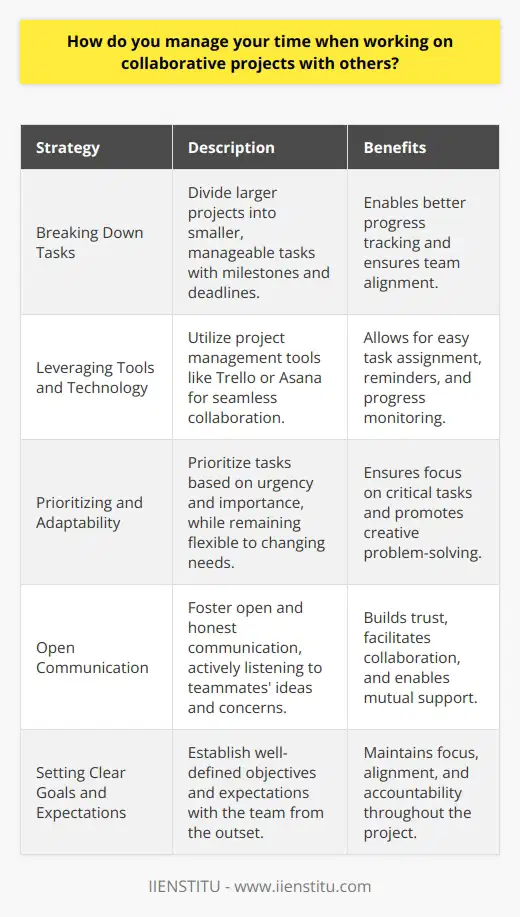
What strategies do you use to stay focused during long meetings or conference calls?
To stay focused during long meetings or conference calls, I employ several strategies that help me remain engaged and attentive.
Taking Notes
I find that actively taking notes keeps my mind from wandering and helps me retain important information. Jotting down key points, action items, and questions ensures that I'm actively listening and processing the discussion.
Minimizing Distractions
Before the meeting begins, I close unnecessary tabs, silence notifications, and put my phone on vibrate. This creates an environment conducive to concentration and prevents interruptions that could derail my focus.
Participating in the Discussion
Instead of being a passive listener, I make an effort to contribute to the conversation when appropriate. Asking questions, sharing insights, and providing updates keeps me invested in the topic at hand.
Taking Short Breaks
If the meeting is particularly lengthy, I find it helpful to take brief mental breaks when possible. During moments when my input isn't required, I might stretch, take a few deep breaths, or jot down a quick reminder for later.
By implementing these strategies, I'm able to maintain focus and actively engage in long meetings and conference calls. It's an approach that has served me well in my previous roles and one that I will continue to refine as I grow professionally.
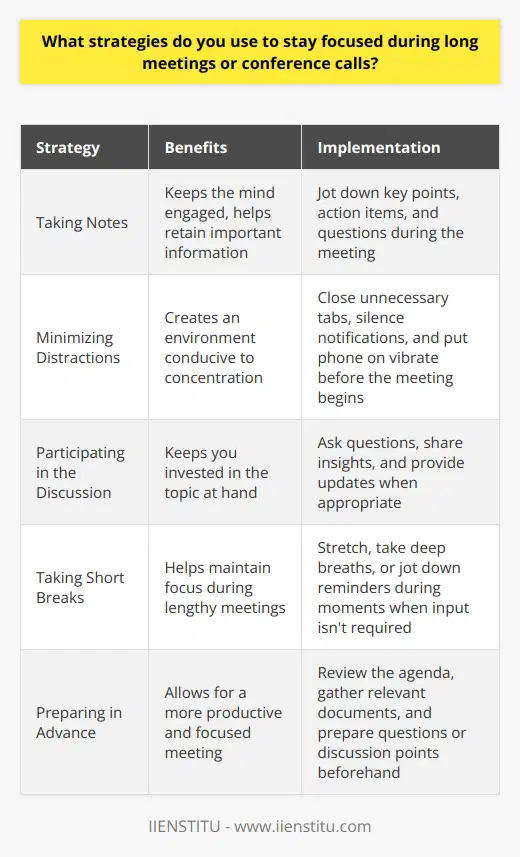
How do you prioritize your personal and professional responsibilities?
I prioritize my personal and professional responsibilities by setting clear goals and boundaries. I believe in maintaining a healthy work-life balance, which allows me to excel in both areas.
Setting Clear Goals
I start by defining my short-term and long-term objectives, both personally and professionally. This helps me focus my efforts and allocate my time and energy efficiently.
I break down larger goals into smaller, manageable tasks and set realistic deadlines for each. This approach enables me to make steady progress and avoid feeling overwhelmed.
Effective Time Management
I use various tools, such as calendars and to-do lists, to organize my tasks and commitments. I prioritize tasks based on their urgency and importance, tackling the most critical ones first.
I also set aside dedicated time for personal activities, like spending quality moments with loved ones and pursuing hobbies. This helps me recharge and maintain a positive outlook.
Maintaining Boundaries
I believe in setting clear boundaries between my personal and professional life. When I'm at work, I focus on my job responsibilities and minimize personal distractions.
Similarly, when I'm off the clock, I disconnect from work-related matters and give my full attention to personal pursuits. This separation helps me be present and engaged in both aspects of my life.
Flexibility and Adaptability
I understand that life can be unpredictable, and priorities may shift unexpectedly. When faced with challenges or competing demands, I remain flexible and adapt my plans accordingly.
I communicate openly with my colleagues and loved ones about any changes in my schedule or commitments. This transparency helps maintain trust and understanding in both personal and professional relationships.
By setting clear goals, managing my time effectively, maintaining boundaries, and staying adaptable, I successfully prioritize my personal and professional responsibilities. This approach allows me to lead a fulfilling life and contribute my best in all areas.
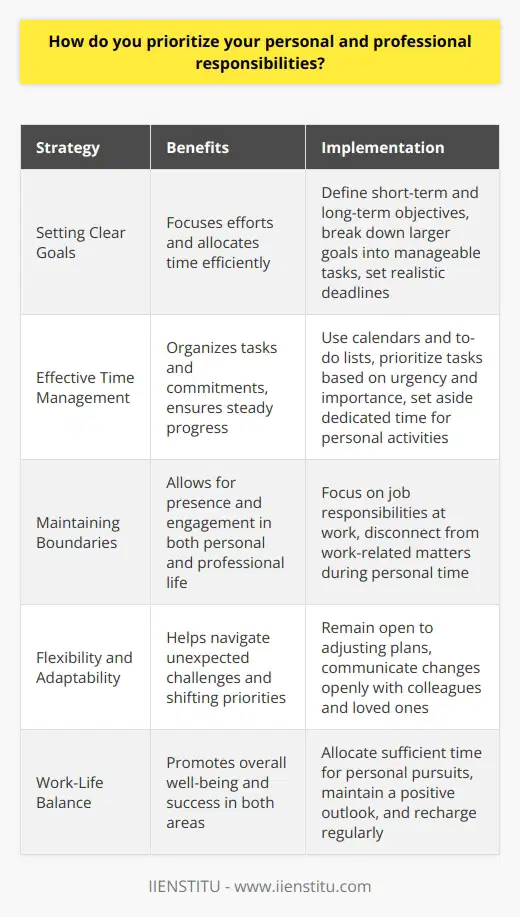
What do you do to maintain your concentration when working on tedious tasks?
When faced with tedious tasks, I employ several strategies to maintain my concentration and stay focused. First, I break the task down into smaller, manageable chunks. This helps me feel a sense of progress and accomplishment as I complete each part.
Setting Goals and Rewards
I set mini-goals for myself throughout the task and reward myself when I reach them. For example, after completing a certain number of items, I might allow myself a short break or a quick stretch. These small rewards keep me motivated and energized.
Minimizing Distractions
To maintain concentration, I minimize distractions in my work environment. I put my phone on silent, close unnecessary browser tabs, and find a quiet space to work. If I'm in a shared office, I might use noise-cancelling headphones to block out background noise.
Varying My Approach
When possible, I try to vary my approach to the task to keep things interesting. This might involve alternating between different parts of the project or using different tools or techniques. By mixing things up, I prevent boredom and maintain my focus.
Staying Physically Energized
Finally, I prioritize my physical well-being to maintain mental stamina. I make sure to take regular breaks to stretch, walk around, and stay hydrated. I also aim for a balanced diet and sufficient sleep to keep my energy levels up throughout the workday.
By employing these strategies, I'm able to stay focused and productive even when working on tedious tasks. It's all about finding what works best for you and staying committed to the process.
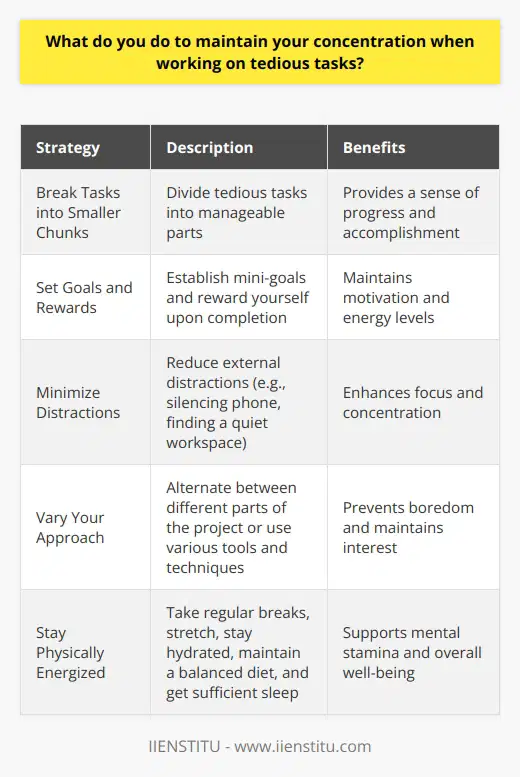
How do you handle situations when you're waiting for input or feedback from others?
When waiting for input or feedback from others, I take a proactive approach to stay productive and efficient. Rather than simply waiting idly, I use the time to work on other important tasks and projects that can be progressed independently.
Prioritizing Tasks
I prioritize my to-do list, focusing on high-priority items that don't require immediate input from others. This allows me to make the most of my time and ensures that I'm continuously contributing to the team's goals.
Communicating Effectively
I maintain open lines of communication with my colleagues, providing clear updates on my progress and any potential roadblocks. If the input or feedback is time-sensitive, I follow up politely to ensure timely responses.
Anticipating Needs
Drawing from my experience, I try to anticipate the information or resources I might need from others in advance. By planning ahead and communicating early, I can minimize delays and keep projects moving forward smoothly.
Adapting and Problem-Solving
When faced with unexpected delays, I remain flexible and adaptable. I explore alternative approaches or find creative solutions to work around the temporary roadblock until I receive the necessary input.
Throughout my career, I've learned that effective communication, proactive planning, and adaptability are key to handling situations where I'm dependent on others' input or feedback. By staying organized, communicating clearly, and making the most of my time, I ensure that projects stay on track and deadlines are met.

What techniques do you use to avoid overcommitting yourself?
To avoid overcommitting myself, I prioritize my tasks and responsibilities based on their importance and urgency. This helps me focus on the most critical tasks and ensures that I don't take on more than I can handle.
Setting realistic expectations
I always strive to set realistic expectations with my colleagues and superiors. If I feel that a task or project is beyond my current capacity, I communicate this clearly and work with them to find a solution.
Time management techniques
I use various time management techniques, such as the Pomodoro Technique and time blocking, to ensure that I'm using my time efficiently. These techniques help me stay focused and avoid procrastination, which can lead to overcommitment.
Delegation and collaboration
When appropriate, I delegate tasks to others who have the skills and capacity to handle them. I also actively seek opportunities to collaborate with my colleagues, which allows us to share the workload and avoid overcommitting any one person.
Regular review and adjustment
I regularly review my commitments and adjust my priorities as needed. If I find that I've taken on too much, I communicate with my team and work to redistribute tasks or adjust deadlines.
By using these techniques, I'm able to manage my workload effectively and avoid overcommitting myself, while still delivering high-quality work and meeting the needs of my team and organization.
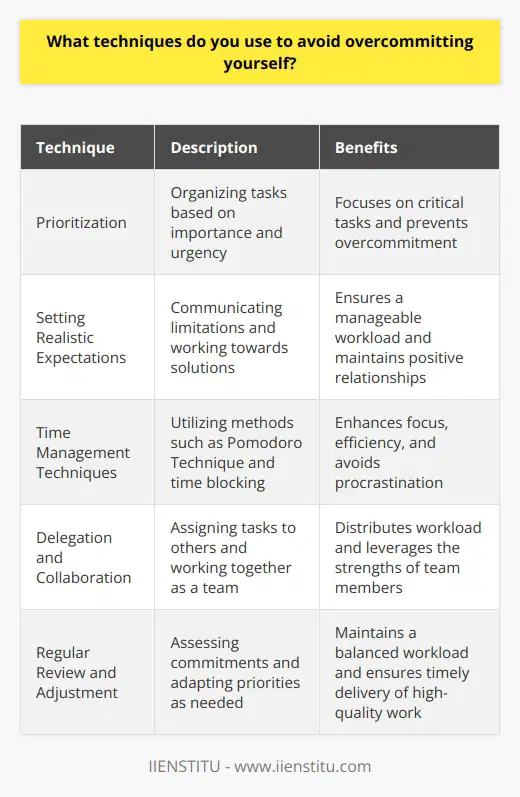
How do you ensure that you have enough time for planning and strategic thinking?
I ensure that I have enough time for planning and strategic thinking by prioritizing my tasks effectively. Every morning, I review my to-do list and identify the most important items that require deep thought and analysis. I block out dedicated time slots in my calendar for these strategic tasks, treating them as non-negotiable appointments with myself.
Minimizing Distractions
During these focused work sessions, I minimize distractions by silencing notifications on my devices and finding a quiet space to work. I've found that even brief interruptions can disrupt my train of thought, so I do my best to eliminate them. If necessary, I communicate my availability to colleagues and ask not to be disturbed unless it's urgent.
Breaking Down Complex Projects
When faced with large, complex projects, I break them down into smaller, manageable steps. This approach helps me avoid feeling overwhelmed and allows me to make steady progress. I set realistic milestones and deadlines for each phase of the project, ensuring that I allocate sufficient time for planning and execution.
Leveraging Technology and Tools
I leverage various productivity tools and techniques to maximize my efficiency. For example, I use mind mapping software to brainstorm ideas and visualize connections between different concepts. I also rely on project management tools to track my progress and ensure that I'm staying on schedule.
By consistently applying these strategies, I'm able to carve out dedicated time for planning and strategic thinking, even amidst a busy workday. I believe that investing in these focused sessions ultimately leads to better decision-making and more impactful results for the organization.
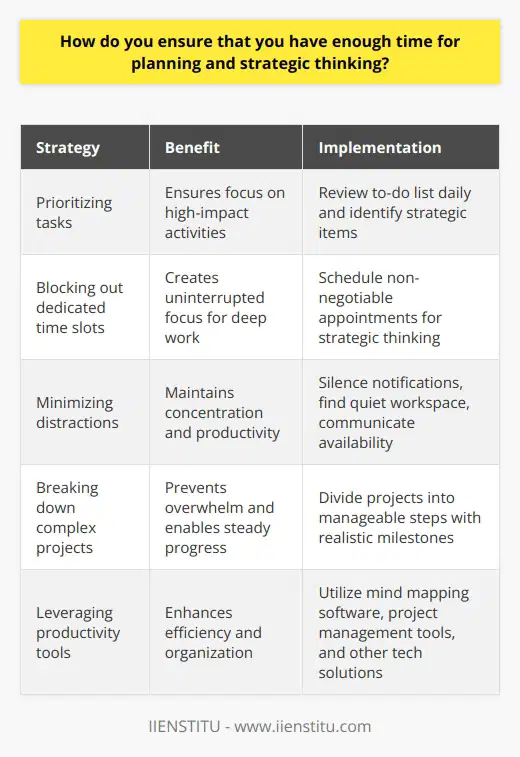
What do you do to stay organized when managing multiple projects simultaneously?
When managing multiple projects simultaneously, I rely on a combination of digital tools and personal habits to stay organized. I use project management software like Trello to create boards for each project, breaking them down into manageable tasks and setting deadlines. This helps me visualize my workload and prioritize effectively.
Prioritizing and Time-Blocking
I prioritize my tasks based on urgency and importance, ensuring that I tackle the most critical items first. Time-blocking is another strategy I employ, where I dedicate specific time slots to each project. This keeps me focused and prevents me from getting overwhelmed by constantly switching between tasks.
Regular Check-Ins and Updates
I schedule regular check-ins with my team and stakeholders to provide updates on project progress and address any issues. These meetings help me stay accountable and ensure that everyone is on the same page. I also make it a habit to send brief email updates to keep everyone informed between meetings.
Maintaining a Clean Workspace
I find that maintaining a clean and organized workspace, both physically and digitally, is crucial for staying focused. I declutter my desk regularly and use digital folders to keep my files organized. Having a tidy environment helps me feel in control and reduces distractions.
Embracing Flexibility and Adaptability
Despite my best efforts to stay organized, I understand that unexpected challenges can arise. I remain flexible and adaptable, ready to adjust my plans when necessary. By staying calm under pressure and being open to change, I can navigate the complexities of managing multiple projects successfully.
